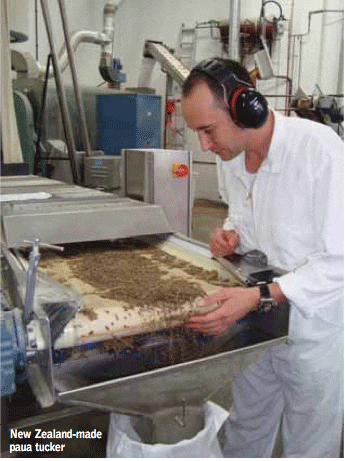Unfortunately, this has a trickle-down effect throughout the related industry, for example feed manufacture. That technology gap manifested itself here in the mid-1990s, with NRMs fleeting foray into salmon feed.
The result is large-scale extruded aquaculture feed production has yet to be tried again in New Zealand. There are now only two manufacturers of aquaculture feed in New Zealand. CRT in the South Island produces relatively small volumes of salmon feed on a pellet press, and EN Hutchinson Ltd in Auckland has a small extruder producing a range of niche aquaculture feed.
Not withstanding those two companies, New Zealand relies almost completely on imported feed and depends totally on the developments of foreign companies to improve the feed used on our farms. Compare this with our agricultural sector and it beggars belief that a country with such a vast coastline could have two related industries where development and funding are such polar opposites. To this end, New Zealand is exposed to the whims of international aquaculture feed companies and is not at liberty to control ingredient source or quality.
These are important factors when attempting to brand New Zealand-grown produce and also the increased potential risk of importing diseases.
Most imported feed products are of very high standard and the process conditions used in manufacture mitigate most (but not all) of the microbial-born disease risk. There is always the potential for out-of-spec or post-manufacture contamination, a risk (however small) we have no control over at present. The advantages of home grown supply are substantive, including reduced lead times for ordering (easing cash flows as well as storage and supply issues), tailor-made feed and good supplier-customer relationships.
Close customer relationships have a significant impact on product development. There is nothing quite like being able to request minor variations and have them supplied month by month in order to capitalise on performance improvements on the farm. If the industry continues to stagnate, there is a real danger that green shoots supply businesses built on a promise will wilt and fade away.
Besides the politicians, another hurdle to overcome is the banal anti-aquaculture rhetoric from the far left Green fringe, which does not bare scrutiny. At a recent lecture I presented in the United States, I described how Greenpeace had forced the abandonment of plans to re-fire the never-commissioned Marsden power station. The heated effluent from this station would have been invaluable as a method for manipulating water temperature in surrounding aquaculture facilities. The stacks have now been removed and Marsden can never be fired up.

This seemed utterly incomprehensible to the Americans, while to us here in New Zealand it has become the norm, and we fail as a country to appreciate the long-term magnitude of such shortsightedness.
We can only hope this over-regulated industry will eventually spring forth, due the determination of a hardy few, resulting in a burgeoning of many trickle-down businesses waiting in the wings dont hold your breath.

